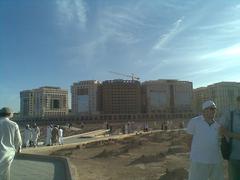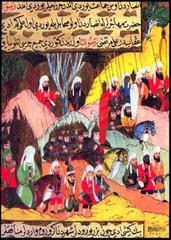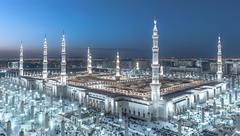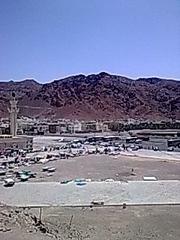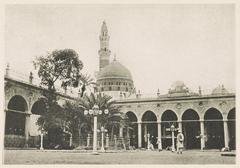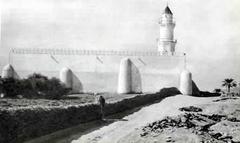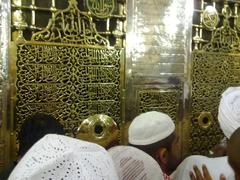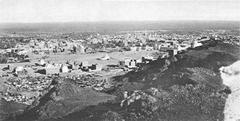Al-Ijabah Mosque: Visiting Hours, Tickets, and Medina Historical Sites Guide
Date: 15/06/2025
Introduction
Al-Ijabah Mosque—also known as Masjid Bani Muawiya or Masjid al-Mubahalah—is a revered site in the holy city of Medina, Saudi Arabia. Situated approximately 600 meters north of Al-Masjid an-Nabawi and close to Jannat al-Baqi cemetery, the mosque stands as a symbol of faith, hope, and historical continuity within Islamic tradition. Its name, “Ijabah,” meaning “acceptance,” is rooted in a significant event during the Prophet Muhammad’s (peace be upon him) life, when his prayers were answered here. Today, Al-Ijabah Mosque is cherished for its tranquil setting, architectural simplicity, and profound religious heritage, welcoming visitors who seek spiritual connection and historical understanding.
This guide provides an in-depth overview of Al-Ijabah Mosque’s history, architecture, religious significance, visiting details, etiquette, and its context within Medina’s constellation of sacred sites. Whether you are a pilgrim, a history enthusiast, or a traveler interested in Islamic culture, this guide will help you plan a respectful and meaningful visit (Madain Project; HolyHajjNumrah; People of Madina).
Table of Contents
- Historical Origins of Al-Ijabah Mosque
- Architectural Features and Preservation
- Religious Significance and Spiritual Legacy
- Role in Early Islamic Community
- Visiting Al-Ijabah Mosque: Practical Information
- Visitor Etiquette and Dress Code
- Accessibility, Facilities, and Nearby Amenities
- Nearby Medina Historical Sites
- Frequently Asked Questions (FAQ)
- Summary Table: Key Facts
- Conclusion and Visitor Recommendations
- Sources and Further Reading
Historical Origins of Al-Ijabah Mosque
Al-Ijabah Mosque (Masjid al-Ijabah, مسجد الإجابة) is one of Medina’s oldest and most significant mosques. Built in the Bani Muawiya district, around 600 meters north of the Prophet’s Mosque and 385 meters from Jannat al-Baqi, its origins are directly linked to the Prophet Muhammad (peace be upon him).
The mosque’s name commemorates an event recorded in Sahih Muslim: the Prophet prayed two rakats here and made three supplications—two of which Allah accepted, and one (regarding the end of internal strife in the Muslim community) was not accepted (Madain Project). This event has defined the mosque’s enduring spiritual legacy.
Architectural Features and Preservation
Al-Ijabah Mosque exemplifies the simplicity of early Islamic architecture. The original structure was modest, with a single prayer hall and courtyard, designed for local worship rather than large congregations. Through the centuries, especially during the Ottoman and Saudi eras, the mosque has undergone careful restoration to maintain its original character and structural integrity (Madain Project).
Key features include:
- White, understated exterior with a single slender minaret.
- Simple prayer hall accommodating several hundred worshippers.
- Minimal ornamentation focusing on spiritual reflection rather than grandeur.
- Small, shaded courtyard for overflow worshippers and quiet contemplation.
These elements preserve the humility and authenticity of 7th-century mosque design, offering visitors an intimate atmosphere for prayer and reflection.
Religious Significance and Spiritual Legacy
Al-Ijabah Mosque’s religious importance stems from the Prophet Muhammad’s supplications made at this site. According to tradition, his prayers for protection from famine and enemies were accepted, while the prayer regarding internal discord was left as a test for the Muslim community (Madain Project). This narrative highlights the mosque as a site of divine response, hope, and reflection on unity.
Muslims visit Al-Ijabah Mosque to perform voluntary prayers and supplications, seeking blessings and drawing inspiration from the Prophet’s example. The mosque’s quiet environment supports personal reflection and spiritual renewal.
Role in Early Islamic Community
In the early Islamic period, Medina featured numerous small mosques serving local neighborhoods and tribes. Al-Ijabah Mosque was associated with the Bani Muawiya clan and the Ansar, the Prophet’s supporters in Medina. It served as a venue for local worship, community gatherings, and religious instruction, complementing the central role of Al-Masjid an-Nabawi (Madain Project; wikipedia).
Visiting Al-Ijabah Mosque: Practical Information
Visiting Hours
Al-Ijabah Mosque is open daily, generally aligning with the five daily prayer times. It remains open from early morning (Fajr) until after the night prayer (Isha). During Ramadan and Hajj seasons, hours may be extended to accommodate more visitors (tripxl.com).
Entrance and Ticketing
Visiting Al-Ijabah Mosque is free of charge; no tickets or reservations are required. Donations for mosque maintenance are welcome.
Guided Tours and Special Events
While the mosque does not host official guided tours, local tour operators frequently include Al-Ijabah Mosque in their Medina historical sites itineraries. Special religious events and lectures take place during Ramadan and Islamic holidays.
Visitor Etiquette and Dress Code
Respect for religious customs is essential at Al-Ijabah Mosque (intosaudia.com; adventuretoeverycountry.com):
- Dress Modestly: Women should cover their hair and wear long, loose clothing. Men should wear long trousers and shirts covering the shoulders.
- Remove Shoes: Leave shoes in designated racks before entering prayer spaces.
- Maintain Silence: Refrain from loud conversations and set phones to silent.
- Photography: Ask permission before taking photos, especially inside the mosque.
- Gender Segregation: Separate entrances and prayer areas for men and women are clearly marked.
Non-Muslims may view the mosque’s exterior but are generally not permitted inside the prayer hall.
Accessibility, Facilities, and Nearby Amenities
Accessibility
- Central Location: Walkable from Al-Masjid an-Nabawi and Jannat al-Baqi.
- Transport: Easily accessible by foot, taxi, or ride-hailing apps (Uber, Careem); limited parking nearby.
- Disability Access: The mosque features ramps and a single-level prayer hall, though accessible restrooms may be limited.
Facilities
- Ablution (Wudu) Areas: Clean facilities for men and women.
- Restrooms: Modern but basic; carry tissues as some may not provide toilet paper.
- Prayer Halls: Separate air-conditioned spaces for men and women.
- Drinking Water: Free coolers available.
- Shops and Eateries: Small shops nearby sell religious items, snacks, and souvenirs.
Nearby Medina Historical Sites
- Al-Masjid an-Nabawi: The Prophet’s Mosque, Medina’s spiritual centerpiece (nomadicsamuel.com).
- Jannat al-Baqi: Historic cemetery for the Prophet’s family and companions.
- Quba Mosque: The first mosque in Islam, a short drive away (regencyholidays.com).
- Mount Uhud: Site of the Battle of Uhud, significant for Islamic history.
- Dar Al Madinah Museum: Exhibits spanning the city’s history (saudiarabiaimmigration.org).
Frequently Asked Questions (FAQ)
Q: What are the visiting hours for Al-Ijabah Mosque?
A: Open daily from Fajr (early morning) until after Isha (night prayer); extended hours during Ramadan and Hajj.
Q: Is there an entrance fee or ticket?
A: No, entry is free for all visitors.
Q: Are guided tours available?
A: Not officially, but many local tour operators include the mosque in their Medina tours.
Q: Can non-Muslims enter Al-Ijabah Mosque?
A: Generally, non-Muslims may view the exterior but are not permitted inside.
Q: Is the mosque accessible for people with disabilities?
A: Yes, ramps and single-level halls are provided, though facilities may be basic.
Q: Is photography allowed?
A: Photography outside is usually permitted; always seek permission before photographing inside.
Summary Table: Key Facts
| Feature | Details |
|---|---|
| Alternative Names | Masjid Bani Muawiya, Masjid al-Mubahalah |
| Location | Bani Muawiya district, ~600m north of Al-Masjid an-Nabawi, Medina |
| Historical Event | Prophet Muhammad’s three supplications (two accepted) |
| Architectural Style | Simple, single prayer hall, small courtyard |
| Era of Origin | Early 7th century CE (Prophet’s lifetime) |
| Renovations | Ottoman and Saudi periods |
| Religious Significance | Site of answered prayers, reflection on unity and divine wisdom |
| Visitor Experience | Quiet, contemplative, less crowded than major pilgrimage sites |
| Proximity to Landmarks | Near Jannat al-Baqi and Al-Masjid an-Nabawi |
Conclusion and Visitor Recommendations
Al-Ijabah Mosque embodies the humility, hope, and continuity of Islamic tradition in Medina. Its accessible location, free entry, and peaceful environment make it an essential stop for those seeking spiritual reflection or insight into early Islamic history. Visitors are encouraged to dress modestly, respect prayer times, and explore nearby historical sites for a comprehensive Medina experience.
Download the Audiala app for guided tours, prayer times, and real-time updates on Medina’s religious sites. Follow our channels for further articles and travel tips to enrich your journey.
Sources and Further Reading
- Al-Ijabah Mosque in Medina: Visiting Hours, Tickets, and Historical Significance (Madain Project)
- Al-Ijabah Mosque in Medina: Visiting Hours, History, and Travel Tips (HolyHajjNumrah)
- Al-Ijabah Mosque Visiting Hours, Etiquette, and Visitor Guide (Intosaudia; VisitAlMadinah)
- Al-Ijabah Mosque: Visiting Hours, Tickets, and Nearby Medina Historical Sites (Regency Holidays; People of Madina)
